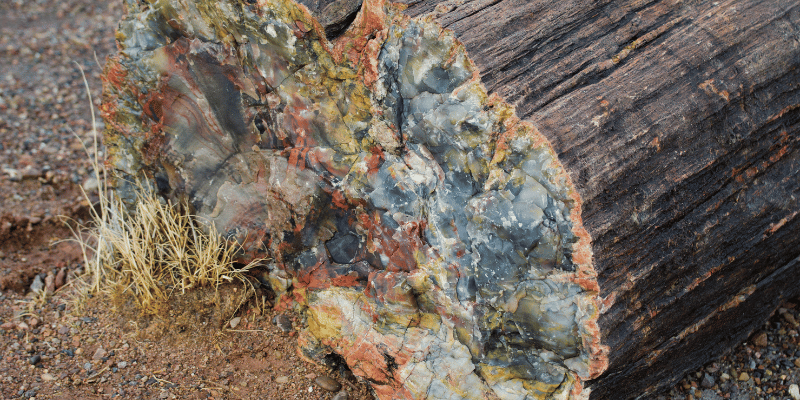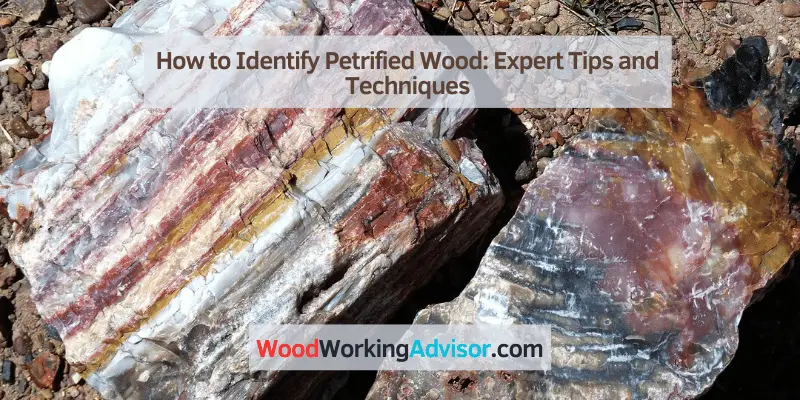Identifying petrified wood can be done by examining the wood’s color, texture, and weight. The wood will have a distinctly different appearance from regular wood, with a stone-like appearance and weight.
Petrified wood is a fascinating natural phenomenon that captivates the interest of geology enthusiasts and collectors alike. Its unique transformation from organic matter to stone captures the imagination and tells a story of ancient landscapes and processes. Identifying petrified wood can be an exciting endeavor, and understanding its distinctive features is essential for enthusiasts and collectors.
By examining its color, texture, and weight, one can distinguish petrified wood from regular wood. In this guide, we will explore the key characteristics to help you identify petrified wood and appreciate its natural beauty. Let’s delve into the intriguing world of petrified wood and uncover its unique attributes.
Begin Your Quest For Petrified Wood
Are you ready to embark on an exciting journey to discover the world of petrified wood? Identifying petrified wood can be an enlightening and fascinating experience, as it provides a glimpse into Earth’s ancient history. Let’s delve into the significance of petrified wood and equip ourselves with the essential tools and mindset required for this exciting quest.
Understand The Significance Of Petrified Wood
Petrified wood holds immense significance due to its unique formation process. Over millions of years, wood transforms into stone through a process called petrification, where organic material is replaced by minerals. This remarkable transformation yields beautiful patterns and colors, offering a glimpse into the geological history of the Earth. Each piece of petrified wood is a tangible link to our planet’s distant past, making it a valuable and intriguing specimen for collectors and enthusiasts alike.
Get Ready With The Right Tools And Mindset
To identify petrified wood effectively, it’s crucial to have the right tools and a focused mindset. Before setting out on your quest, ensure you have a few essential items in your toolkit:
- Hand lens: A hand lens or magnifying glass is invaluable for examining the intricate details of petrified wood, such as growth rings and cell structures.
- Geological hammer: A sturdy geological hammer will aid in extracting samples and examining the internal structure of petrified wood specimens.
- Field guide: Carry a reliable field guide to petrified wood, providing insights into different species, locations, and identification techniques.
- Curiosity and patience: Approach your quest with a curious and patient mindset. Petrified wood identification may require careful observation and research, so a patient approach is key to success.
With the right tools and a determined mindset, you’ll be well-prepared to uncover the captivating world of petrified wood.

Natural Markers Of Petrified Wood
Petrified wood is a fascinating natural wonder that has been transformed over millions of years. Understanding the natural markers of petrified wood can help identify this unique material and appreciate its beauty. By recognizing the color variations, patterns, and textures, you can become adept at distinguishing petrified wood from other materials.
Identify The Color Variations
One of the distinctive features of petrified wood is its color variations, which result from the presence of different mineral residues. Petrified wood can exhibit a wide range of colors, including earthy browns, vibrant reds, subtle yellows, and rich blacks. These colors often create captivating patterns within the wood, adding to its allure.
Recognize The Patterns And Textures
Patterns and textures in petrified wood provide crucial clues for identification. The growth rings of the original tree can often be seen in the cross-section of petrified wood, resembling those found in contemporary trees. Additionally, the presence of crystalline structures and mineral inclusions can contribute to the unique appearance of petrified wood, making it distinguishable from other fossils or rocks.
Incorporating Expert Tips
When it comes to identifying petrified wood, getting expert insights can make a significant difference. By seeking knowledge from experienced geologists and learning from their field experiences, you can enhance your understanding of petrified wood and effectively identify it.
Seek Expert Insights On Petrified Wood
Consulting with experts in the field of petrified wood can provide valuable insights into the characteristics, formation, and identification of this unique natural phenomenon. By seeking guidance from knowledgeable individuals, you can gain a deeper understanding of petrified wood and its distinguishing features.
Learn From Geological Field Experiences
Geological field experiences offer an invaluable opportunity to observe and study petrified wood in its natural environment. By accompanying experienced geologists on field excursions, you can gain firsthand knowledge of the geological processes that contribute to the formation of petrified wood. Observing different specimens and geological formations can provide practical insights that enhance your ability to identify petrified wood with accuracy.
How To Identify Petrified Wood: Analysis Techniques
When it comes to identifying petrified wood, analysis techniques play a crucial role in determining its authenticity and origin. By utilizing various analysis methods, one can gain valuable insights into the composition, age, and environmental context of petrified wood. This article will delve into the analysis techniques, focusing on weight and hardness tests as well as examining the environmental context.
Weight And Hardness Tests
Weight and hardness tests are essential analysis techniques for identifying petrified wood. By conducting these tests, one can assess the physical properties of the specimen, which can provide valuable clues about its composition and authenticity. Petrified wood is generally heavier and harder than ordinary wood due to the fossilization process, making weight and hardness tests reliable indicators of its petrified nature.
Examining The Environmental Context
Examining the environmental context is a critical aspect of identifying petrified wood. This analysis technique involves assessing the geological strata, sedimentary layers, and surrounding fossils in which the petrified wood is found. By understanding the environmental context, one can determine the geological age of the specimen, the type of prehistoric flora it originated from, and the specific conditions that led to its fossilization.
Unveiling The Mystery Of Petrified Wood
Study The Historical And Geographical Aspects
One of the crucial steps in identifying petrified wood is to delve into its historical and geographical aspects. By understanding the origins and the environments in which petrified wood is formed, you can gain insights into its unique characteristics. Exploring the formation process can reveal fascinating details about the ancient wood and the conditions it underwent to become petrified.
Relate Your Findings To Scientific Knowledge
Connecting your findings to scientific knowledge is essential in the identification of petrified wood. Cross-referencing the characteristics and composition of the samples with known scientific data can unveil important clues about the type and age of the petrified wood. This approach allows for a deeper understanding of the geological processes and the distinctive features exhibited by petrified wood.
Enhancing Identification Skills
Enhancing your skills in identifying petrified wood is essential for enthusiasts and collectors. By honing your abilities, you can confidently distinguish genuine petrified wood specimens from lookalikes. The following strategies will help you sharpen your identification skills. Let’s delve into some effective methods to improve your petrified wood recognition capabilities.
Join Workshops And Seminars
Engaging in workshops and seminars dedicated to petrified wood identification can provide invaluable insights and hands-on experience. These events are often led by experts in the field who can share their knowledge, offer practical tips, and showcase various specimens for attendees to examine. By participating in these gatherings, you can gain a deeper understanding of the distinct characteristics of petrified wood and learn to differentiate between different types and imitations.
Practice Regular Fieldwork And Sample Comparisons
The best way to enhance your petrified wood identification skills is through consistent fieldwork and sample comparisons. Spending time in natural settings where petrified wood is found allows you to observe the unique features of different specimens firsthand. By comparing various samples and noting the specific patterns, colors, and textures, you can develop a keen eye for recognizing authentic petrified wood. Regular fieldwork also enables you to understand how environmental factors may impact the appearance of petrified wood, aiding you in making accurate identifications.
Frequently Asked Questions For How To Identify Petrified Wood
How Is Petrified Wood Identified?
Petrified wood is identified by its weight, appearance, and hardness. It often has a polished surface and can contain recognizable tree rings and structures. A scratch test can also help determine its hardness. Professional testing and examination can confirm its authenticity.
What Is The Difference Between Petrified Wood And Fossilized Wood?
Petrified wood results from the replacement of organic materials by minerals, preserving the wood’s original structure. Fossilized wood is the result of the wood being replaced by minerals, leading to the preservation of the wood’s organic matter. Both processes involve mineralization, but with different outcomes.
Is Petrified Wood Hard Or Soft?
Petrified wood is hard due to the replacement of organic material by minerals. It retains the original wood structure but is stone-like in hardness. This process is called petrification and results in a durable and sturdy material.
Is Petrified Wood Worth Anything?
Yes, petrified wood can be valuable due to its rarity and unique appearance. It is often sought after by collectors and used for decorative purposes. Prices can vary, but well-preserved pieces can fetch a significant amount.
Conclusion
Identifying petrified wood is a rewarding skill for any enthusiast. By understanding the key characteristics and conducting simple tests, one can confidently differentiate between this fascinating fossilized wood and ordinary rocks. Developing an eye for color, texture, and weight will enhance the appreciation for the natural history and beauty of petrified wood.


